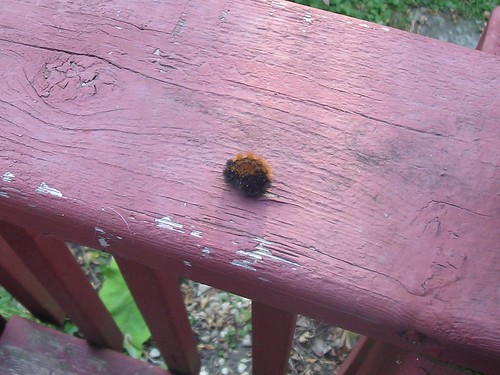 I took the garbage and recycling out yesterday after coming home from work. I found this, a woolly bear caterpillar, on the ground. Yes, he (or is it a she? How does one 'sex' caterpillars or does one?) is curled into a ball, but you can see that roughly half of him is brown and the other half is black.
I took the garbage and recycling out yesterday after coming home from work. I found this, a woolly bear caterpillar, on the ground. Yes, he (or is it a she? How does one 'sex' caterpillars or does one?) is curled into a ball, but you can see that roughly half of him is brown and the other half is black.Woolly bears are the larva of Isabella Tiger moth. At this time of year, when you see them, they are in the process of moving to a sheltered location to spin their cocoons to wait out the winter before become the moth in the spring. They can, very often, be almost everywhere. Folklore developed over the centuries giving these little guys the ability to predict the severity of the winter weather. This isn't altogether untrue because the more of them you see and the more they are moving, it means they know cold weather is coming and they are taking shelter for the winter.
Growing up, my grandfather always said the size of the black area indicated the severity of the winter. The more black there was, the harder the winter. Some folks say the number of segments of each color (There are 13 total.) indicate how long the harsh weather will last as opposed to the mild weather.
Some folks say the thickness of the hairs on the worm's body indicate winter severity. Thick hairs equal harsh while thin hairs equal mild. And others said that if the woolly bear is traveling north, it will be a mild winter. If he's traveling south, batten down the hatches. There's nothing to say what happens if you see him curled in a ball. Did he just give up?
So, in looking at this little guy, my forecast for winter is that we'll get snow and cold and then, about April, we will get rain as the temperatures warm up. How's that for precise science? The Old Farmer's Almanac gives the winter forecast for my region, #6, thus:
Winter will be colder than normal, with the coldest periods in late December, mid- and late January, and mid- and late February. Snowfall and precipitation will be near or slightly above normal in New York and below normal elsewhere. The snowiest periods will be in mid-December, January, and mid-February.According to Esther Lutz, East Central Illinois Master Naturalist, woolly bears have an accuracy rate of 80-85%. (The rest of her article on these little guys is very interesting.) I think that's pretty good, for a bug.
Beverage: Water
Deb
No comments:
Post a Comment